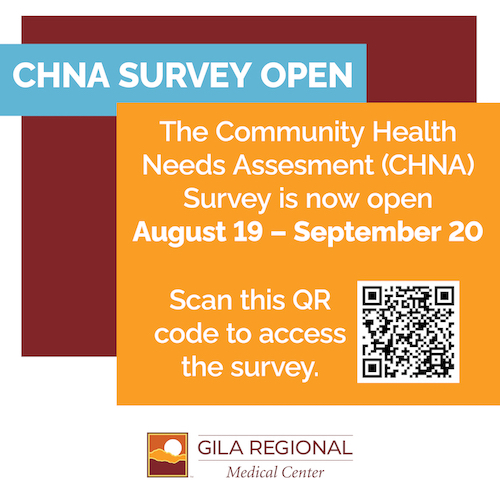By Mary Alice Murphy

The survey can be taken online at this URL https://surveys.holleranconsult.com/s3/GRMCCHNA or in person, as they were at the townhalls.
On Tuesday, Gila Regional Medical Center held two townhalls to answer questions about its Community Health Needs Assessment, which is ongoing until the deadline of Sept. 20.
GRMC Chief Executive Officer Robert Whitaker led off the session by introducing several hospital employees in attendance, including the Associate Administrator Matthew Stephens, and the consultants from Holleran, who are leading the assessment project.
"Our strategy pillars are to improve patient outcomes; enhance the patient experience; care for the caregiver; reduce the cost of case, growth and operations excellence and build strong community relationships," Whitaker said.
To address patient outcomes, he said the hospital every month holds an orientation for new employees. "No matter what a person does in the hospital, we call them a caregiver. Everyone has an opportunity to interact with patients. At every new caregiver orientation, I tell this story. I think of patients as our customers. And we need to provide customer service."
He told the story about the "My 600-pound Life" program that filmed an episode in the Kansas City hospital where he was working. They called what "we call a patient a cast member. The show wanted to film the after show from one who had been on the show, when she needed a follow up surgery." He noted it required a lot of legal documents and insurance to prepare to film the surgery, which would be on live TV.
"We want patients to leave better than they came in," Whitaker said. "We want to enhance the patient's experience and we strive for that. We want to make sure we are also taking care of our caregivers, so we have strategies and success measures. To reduce the cost of care, I will explain that we are a county-owned hospital with no tax dollars, no mil levy supporting the hospital. We do everything from our own operations. We try to be good stewards of all our operations. Growth is important and so is operations excellence. We have to be better at how we do things. Again we have objectives and success measures. For community relationships, we will offer free football tickets to some local games."
To explain the community health needs assessment, he said it is both a process and a document that investigates and describes the current health status of the community, what has changed since the last assessment and what needs to be done to improve the health of the community.
The process involves collection and analysis of a large range of data, including demographic, socioeconomic, and health statistics as well as feedback from the community and health partners members. The document will summarize all the evidence and will serve as a resource until the next assessment. It serves as a basis for prioritizing the community's health needs and culminates in planning to meet those needs.
Whitaker laid out the social determinants of health. They include education access and quality, healthcare access and quality, economic stability, social and community context and neighborhoods and built environment.
The team puts the information together and that starts the conversations, he said.
"We aren't doing this just for Gila Regional; it's for the whole community," Whitaker said. "We want to help address the gaps in the health and well-being of our community. Which is why we are holding this townhall, having focus groups, having individual surveys and providing everyone in the region the opportunity to participate in the survey. We want your feedback."
He also noted that in addition to being a county-owned hospital, Gila Regional had gained a not-for-profit status and the community health needs assessment is a requirement every three years for charitable and not-for-profit hospitals under the Patient Protection and Affordable Care Act of 2010 and by the Internal Revenue Service.
"The majority of things we are addressing in this survey are also things that we want to be able to meet," Whitaker said. "The intent is not for us to address everything in the assessment. We want to recognize that we can help address these issues and help make plans."
He then took questions.
An attendee asked if the hospital was in compliance with the not-for-profit status. Whitaker replied that this is the first year the assessment has been required, as it is done every three years, and the not-for-profit state was approved a couple of years ago.
Another attendee asked why the hospital was doing the survey if they did not plan to address all the findings.
"We plan to partner with other organizations that are better able to address some of the components," Whitaker replied.
In answer to a question about how the hospital gets funding if it does not receive tax dollars, Whitaker replied: "From our patient care. Plus we get grants for large equipment, such as one we just were awarded to replace our MRI machine."
"You can always ask me about things, too," Whitaker said.
He addressed the rumor that continues in the community. "We are not considering selling the hospital." He also in reply to a question said the Cancer Center is part of the hospital, and is not from another facility. "We do contract with a medical oncologist, Dr. Durando, and a radiological oncologist, Dr. Arsenault, to come to Gila Regional on a regular schedule. We have nurse practitioners on staff that are available. The oncologists are also available by phone, when they are not on site "
He again encouraged everyone to take the survey to help the community improve health care services.










